Planning for Growth
VerifiedAdded on 2023/01/13
|14
|4483
|96
AI Summary
This report discusses the key considerations for identifying growth opportunities, different frameworks such as Porters Generic Strategies and PESTLE analysis, sources of funding with their benefits and drawbacks, and the Ansoff Growth Matrix. It also covers business planning and exit and succession options for small businesses. The case study focuses on KPMG, a consulting firm providing services to SMEs.
Contribute Materials
Your contribution can guide someone’s learning journey. Share your
documents today.
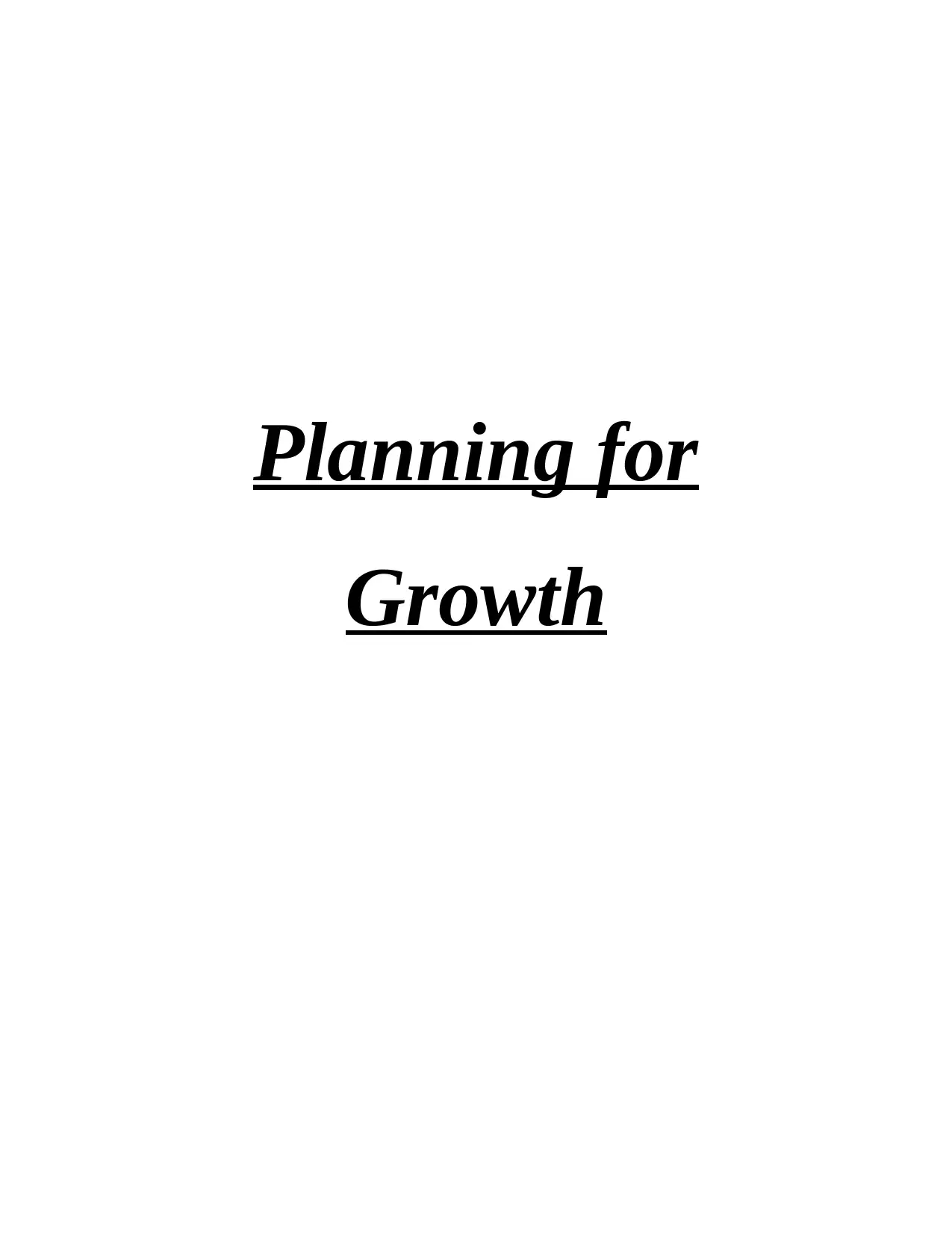
Planning for
Growth
Growth
Secure Best Marks with AI Grader
Need help grading? Try our AI Grader for instant feedback on your assignments.

Table of Contents
INTRODUCTION...........................................................................................................................3
TASK 1............................................................................................................................................3
Evaluation of key considerations for identifying growth opportunities along with different
Frameworks............................................................................................................................3
Sources of Funding with their benefits & drawbacks............................................................6
Ansoff Growth Matrix............................................................................................................8
TASK 2............................................................................................................................................9
Business plan .........................................................................................................................9
TASK 3..........................................................................................................................................11
Assessing exit and succession options for small businesses with their advantages &
drawbacks. ...........................................................................................................................11
CONCLUSION..............................................................................................................................12
REFERENCES..............................................................................................................................14
INTRODUCTION...........................................................................................................................3
TASK 1............................................................................................................................................3
Evaluation of key considerations for identifying growth opportunities along with different
Frameworks............................................................................................................................3
Sources of Funding with their benefits & drawbacks............................................................6
Ansoff Growth Matrix............................................................................................................8
TASK 2............................................................................................................................................9
Business plan .........................................................................................................................9
TASK 3..........................................................................................................................................11
Assessing exit and succession options for small businesses with their advantages &
drawbacks. ...........................................................................................................................11
CONCLUSION..............................................................................................................................12
REFERENCES..............................................................................................................................14
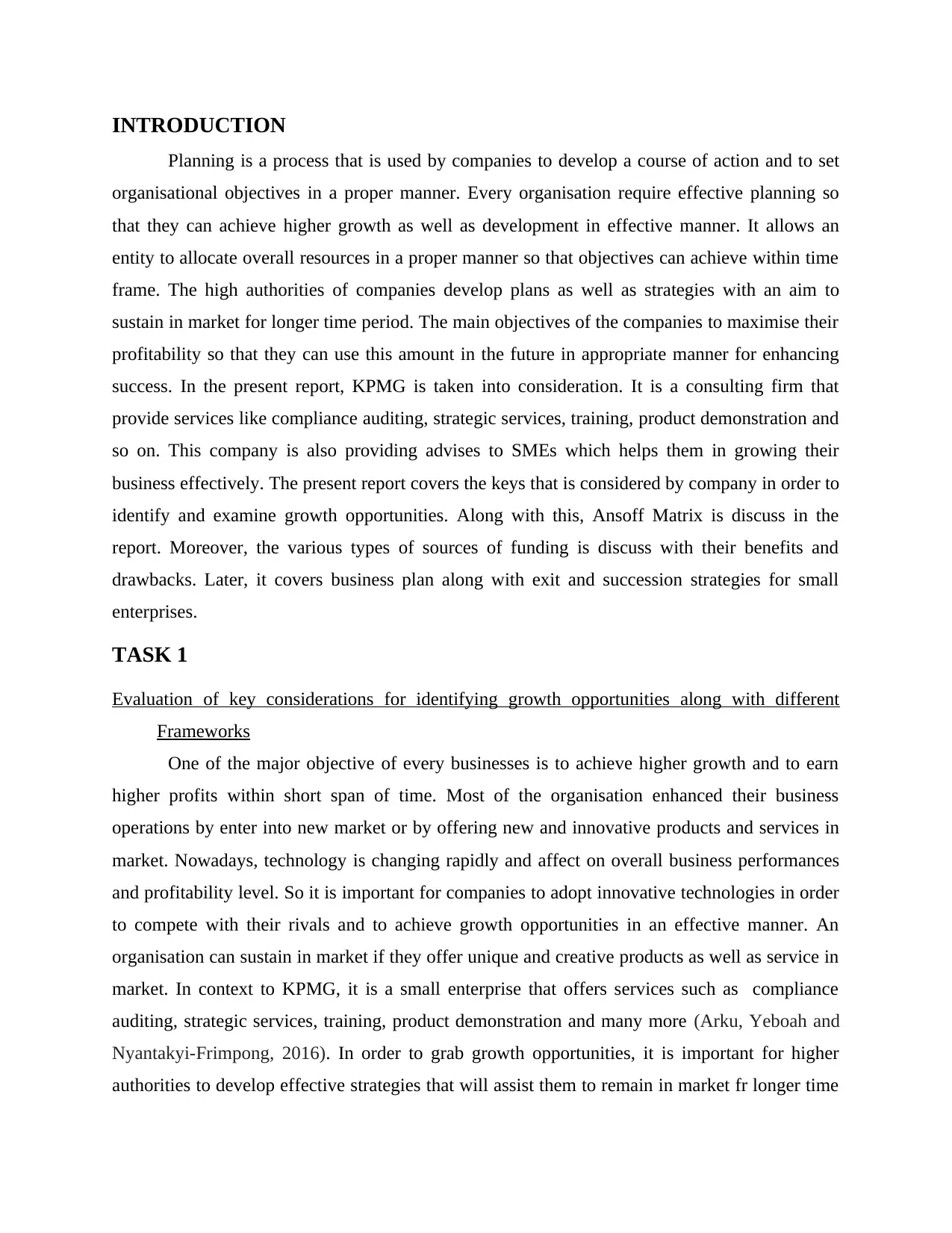
INTRODUCTION
Planning is a process that is used by companies to develop a course of action and to set
organisational objectives in a proper manner. Every organisation require effective planning so
that they can achieve higher growth as well as development in effective manner. It allows an
entity to allocate overall resources in a proper manner so that objectives can achieve within time
frame. The high authorities of companies develop plans as well as strategies with an aim to
sustain in market for longer time period. The main objectives of the companies to maximise their
profitability so that they can use this amount in the future in appropriate manner for enhancing
success. In the present report, KPMG is taken into consideration. It is a consulting firm that
provide services like compliance auditing, strategic services, training, product demonstration and
so on. This company is also providing advises to SMEs which helps them in growing their
business effectively. The present report covers the keys that is considered by company in order to
identify and examine growth opportunities. Along with this, Ansoff Matrix is discuss in the
report. Moreover, the various types of sources of funding is discuss with their benefits and
drawbacks. Later, it covers business plan along with exit and succession strategies for small
enterprises.
TASK 1
Evaluation of key considerations for identifying growth opportunities along with different
Frameworks
One of the major objective of every businesses is to achieve higher growth and to earn
higher profits within short span of time. Most of the organisation enhanced their business
operations by enter into new market or by offering new and innovative products and services in
market. Nowadays, technology is changing rapidly and affect on overall business performances
and profitability level. So it is important for companies to adopt innovative technologies in order
to compete with their rivals and to achieve growth opportunities in an effective manner. An
organisation can sustain in market if they offer unique and creative products as well as service in
market. In context to KPMG, it is a small enterprise that offers services such as compliance
auditing, strategic services, training, product demonstration and many more (Arku, Yeboah and
Nyantakyi-Frimpong, 2016). In order to grab growth opportunities, it is important for higher
authorities to develop effective strategies that will assist them to remain in market fr longer time
Planning is a process that is used by companies to develop a course of action and to set
organisational objectives in a proper manner. Every organisation require effective planning so
that they can achieve higher growth as well as development in effective manner. It allows an
entity to allocate overall resources in a proper manner so that objectives can achieve within time
frame. The high authorities of companies develop plans as well as strategies with an aim to
sustain in market for longer time period. The main objectives of the companies to maximise their
profitability so that they can use this amount in the future in appropriate manner for enhancing
success. In the present report, KPMG is taken into consideration. It is a consulting firm that
provide services like compliance auditing, strategic services, training, product demonstration and
so on. This company is also providing advises to SMEs which helps them in growing their
business effectively. The present report covers the keys that is considered by company in order to
identify and examine growth opportunities. Along with this, Ansoff Matrix is discuss in the
report. Moreover, the various types of sources of funding is discuss with their benefits and
drawbacks. Later, it covers business plan along with exit and succession strategies for small
enterprises.
TASK 1
Evaluation of key considerations for identifying growth opportunities along with different
Frameworks
One of the major objective of every businesses is to achieve higher growth and to earn
higher profits within short span of time. Most of the organisation enhanced their business
operations by enter into new market or by offering new and innovative products and services in
market. Nowadays, technology is changing rapidly and affect on overall business performances
and profitability level. So it is important for companies to adopt innovative technologies in order
to compete with their rivals and to achieve growth opportunities in an effective manner. An
organisation can sustain in market if they offer unique and creative products as well as service in
market. In context to KPMG, it is a small enterprise that offers services such as compliance
auditing, strategic services, training, product demonstration and many more (Arku, Yeboah and
Nyantakyi-Frimpong, 2016). In order to grab growth opportunities, it is important for higher
authorities to develop effective strategies that will assist them to remain in market fr longer time
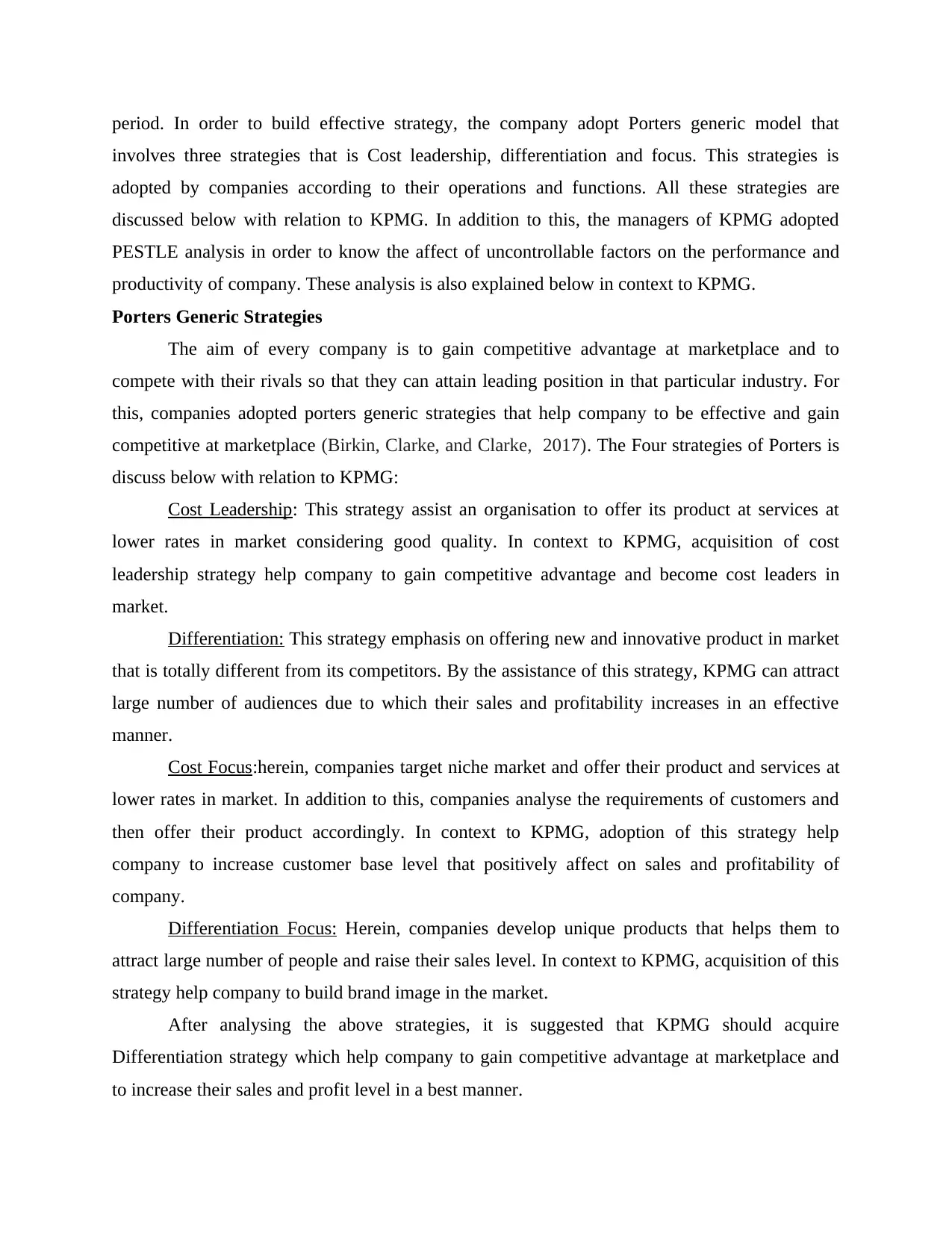
period. In order to build effective strategy, the company adopt Porters generic model that
involves three strategies that is Cost leadership, differentiation and focus. This strategies is
adopted by companies according to their operations and functions. All these strategies are
discussed below with relation to KPMG. In addition to this, the managers of KPMG adopted
PESTLE analysis in order to know the affect of uncontrollable factors on the performance and
productivity of company. These analysis is also explained below in context to KPMG.
Porters Generic Strategies
The aim of every company is to gain competitive advantage at marketplace and to
compete with their rivals so that they can attain leading position in that particular industry. For
this, companies adopted porters generic strategies that help company to be effective and gain
competitive at marketplace (Birkin, Clarke, and Clarke, 2017). The Four strategies of Porters is
discuss below with relation to KPMG:
Cost Leadership: This strategy assist an organisation to offer its product at services at
lower rates in market considering good quality. In context to KPMG, acquisition of cost
leadership strategy help company to gain competitive advantage and become cost leaders in
market.
Differentiation: This strategy emphasis on offering new and innovative product in market
that is totally different from its competitors. By the assistance of this strategy, KPMG can attract
large number of audiences due to which their sales and profitability increases in an effective
manner.
Cost Focus:herein, companies target niche market and offer their product and services at
lower rates in market. In addition to this, companies analyse the requirements of customers and
then offer their product accordingly. In context to KPMG, adoption of this strategy help
company to increase customer base level that positively affect on sales and profitability of
company.
Differentiation Focus: Herein, companies develop unique products that helps them to
attract large number of people and raise their sales level. In context to KPMG, acquisition of this
strategy help company to build brand image in the market.
After analysing the above strategies, it is suggested that KPMG should acquire
Differentiation strategy which help company to gain competitive advantage at marketplace and
to increase their sales and profit level in a best manner.
involves three strategies that is Cost leadership, differentiation and focus. This strategies is
adopted by companies according to their operations and functions. All these strategies are
discussed below with relation to KPMG. In addition to this, the managers of KPMG adopted
PESTLE analysis in order to know the affect of uncontrollable factors on the performance and
productivity of company. These analysis is also explained below in context to KPMG.
Porters Generic Strategies
The aim of every company is to gain competitive advantage at marketplace and to
compete with their rivals so that they can attain leading position in that particular industry. For
this, companies adopted porters generic strategies that help company to be effective and gain
competitive at marketplace (Birkin, Clarke, and Clarke, 2017). The Four strategies of Porters is
discuss below with relation to KPMG:
Cost Leadership: This strategy assist an organisation to offer its product at services at
lower rates in market considering good quality. In context to KPMG, acquisition of cost
leadership strategy help company to gain competitive advantage and become cost leaders in
market.
Differentiation: This strategy emphasis on offering new and innovative product in market
that is totally different from its competitors. By the assistance of this strategy, KPMG can attract
large number of audiences due to which their sales and profitability increases in an effective
manner.
Cost Focus:herein, companies target niche market and offer their product and services at
lower rates in market. In addition to this, companies analyse the requirements of customers and
then offer their product accordingly. In context to KPMG, adoption of this strategy help
company to increase customer base level that positively affect on sales and profitability of
company.
Differentiation Focus: Herein, companies develop unique products that helps them to
attract large number of people and raise their sales level. In context to KPMG, acquisition of this
strategy help company to build brand image in the market.
After analysing the above strategies, it is suggested that KPMG should acquire
Differentiation strategy which help company to gain competitive advantage at marketplace and
to increase their sales and profit level in a best manner.
Secure Best Marks with AI Grader
Need help grading? Try our AI Grader for instant feedback on your assignments.
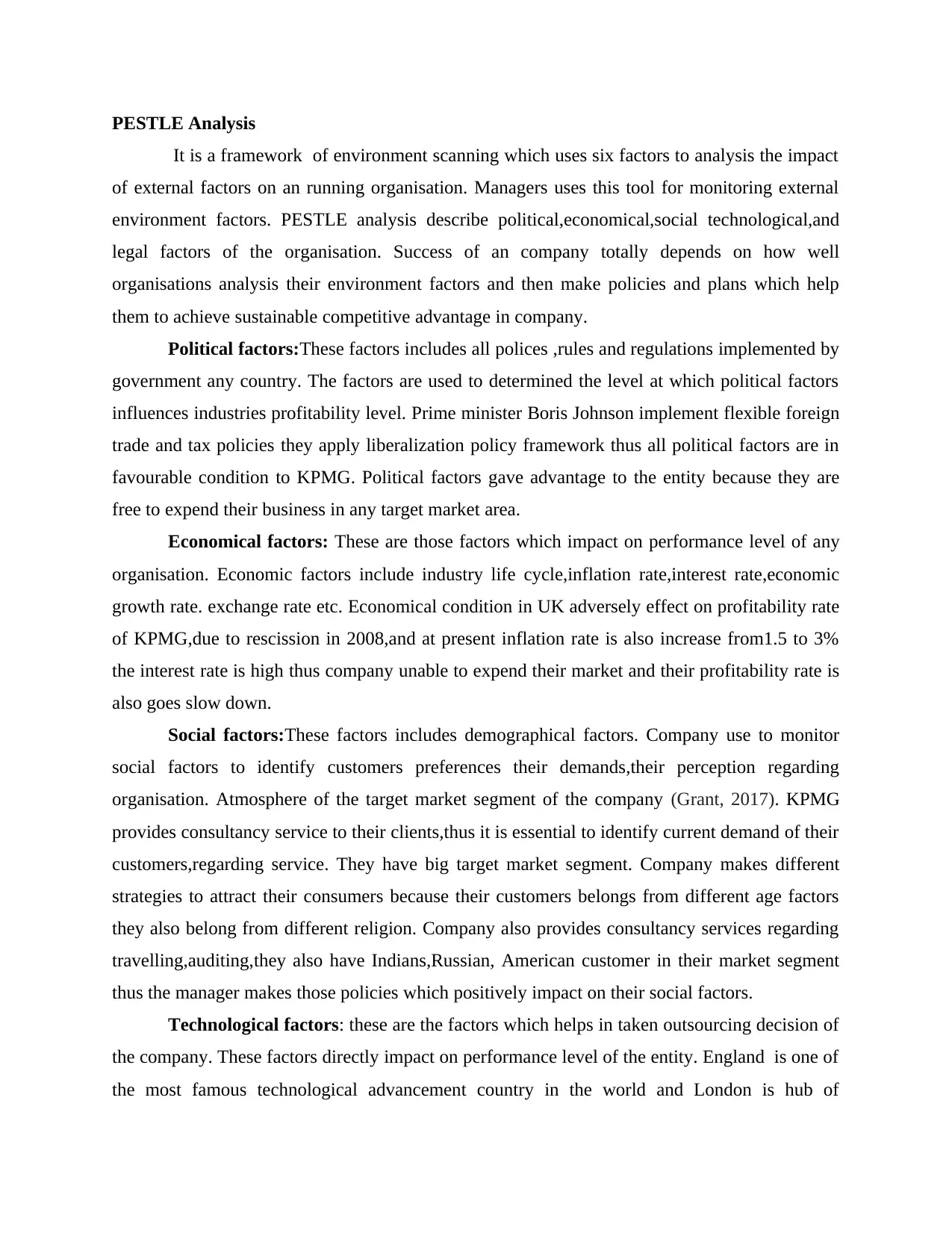
PESTLE Analysis
It is a framework of environment scanning which uses six factors to analysis the impact
of external factors on an running organisation. Managers uses this tool for monitoring external
environment factors. PESTLE analysis describe political,economical,social technological,and
legal factors of the organisation. Success of an company totally depends on how well
organisations analysis their environment factors and then make policies and plans which help
them to achieve sustainable competitive advantage in company.
Political factors:These factors includes all polices ,rules and regulations implemented by
government any country. The factors are used to determined the level at which political factors
influences industries profitability level. Prime minister Boris Johnson implement flexible foreign
trade and tax policies they apply liberalization policy framework thus all political factors are in
favourable condition to KPMG. Political factors gave advantage to the entity because they are
free to expend their business in any target market area.
Economical factors: These are those factors which impact on performance level of any
organisation. Economic factors include industry life cycle,inflation rate,interest rate,economic
growth rate. exchange rate etc. Economical condition in UK adversely effect on profitability rate
of KPMG,due to rescission in 2008,and at present inflation rate is also increase from1.5 to 3%
the interest rate is high thus company unable to expend their market and their profitability rate is
also goes slow down.
Social factors:These factors includes demographical factors. Company use to monitor
social factors to identify customers preferences their demands,their perception regarding
organisation. Atmosphere of the target market segment of the company (Grant, 2017). KPMG
provides consultancy service to their clients,thus it is essential to identify current demand of their
customers,regarding service. They have big target market segment. Company makes different
strategies to attract their consumers because their customers belongs from different age factors
they also belong from different religion. Company also provides consultancy services regarding
travelling,auditing,they also have Indians,Russian, American customer in their market segment
thus the manager makes those policies which positively impact on their social factors.
Technological factors: these are the factors which helps in taken outsourcing decision of
the company. These factors directly impact on performance level of the entity. England is one of
the most famous technological advancement country in the world and London is hub of
It is a framework of environment scanning which uses six factors to analysis the impact
of external factors on an running organisation. Managers uses this tool for monitoring external
environment factors. PESTLE analysis describe political,economical,social technological,and
legal factors of the organisation. Success of an company totally depends on how well
organisations analysis their environment factors and then make policies and plans which help
them to achieve sustainable competitive advantage in company.
Political factors:These factors includes all polices ,rules and regulations implemented by
government any country. The factors are used to determined the level at which political factors
influences industries profitability level. Prime minister Boris Johnson implement flexible foreign
trade and tax policies they apply liberalization policy framework thus all political factors are in
favourable condition to KPMG. Political factors gave advantage to the entity because they are
free to expend their business in any target market area.
Economical factors: These are those factors which impact on performance level of any
organisation. Economic factors include industry life cycle,inflation rate,interest rate,economic
growth rate. exchange rate etc. Economical condition in UK adversely effect on profitability rate
of KPMG,due to rescission in 2008,and at present inflation rate is also increase from1.5 to 3%
the interest rate is high thus company unable to expend their market and their profitability rate is
also goes slow down.
Social factors:These factors includes demographical factors. Company use to monitor
social factors to identify customers preferences their demands,their perception regarding
organisation. Atmosphere of the target market segment of the company (Grant, 2017). KPMG
provides consultancy service to their clients,thus it is essential to identify current demand of their
customers,regarding service. They have big target market segment. Company makes different
strategies to attract their consumers because their customers belongs from different age factors
they also belong from different religion. Company also provides consultancy services regarding
travelling,auditing,they also have Indians,Russian, American customer in their market segment
thus the manager makes those policies which positively impact on their social factors.
Technological factors: these are the factors which helps in taken outsourcing decision of
the company. These factors directly impact on performance level of the entity. England is one of
the most famous technological advancement country in the world and London is hub of
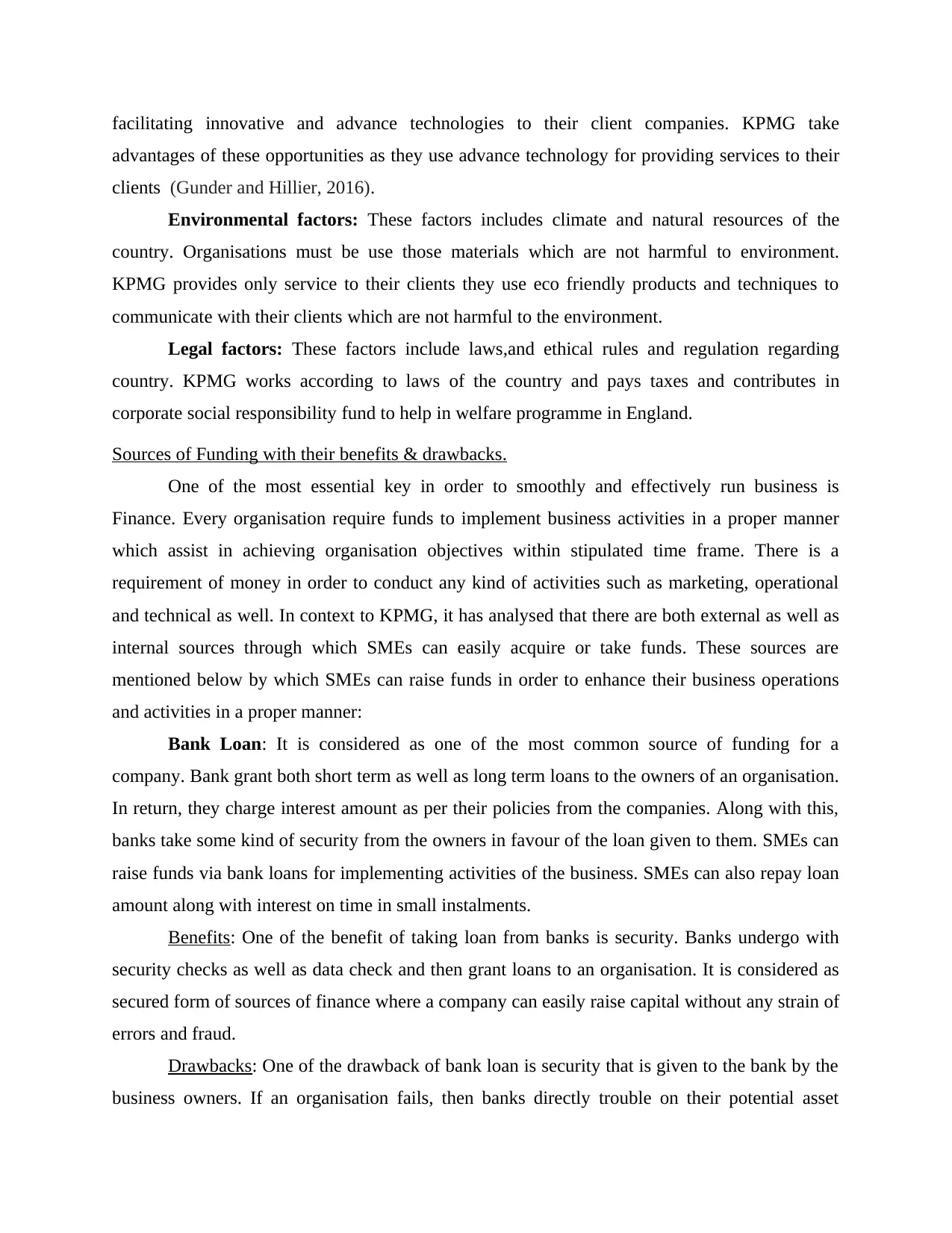
facilitating innovative and advance technologies to their client companies. KPMG take
advantages of these opportunities as they use advance technology for providing services to their
clients (Gunder and Hillier, 2016).
Environmental factors: These factors includes climate and natural resources of the
country. Organisations must be use those materials which are not harmful to environment.
KPMG provides only service to their clients they use eco friendly products and techniques to
communicate with their clients which are not harmful to the environment.
Legal factors: These factors include laws,and ethical rules and regulation regarding
country. KPMG works according to laws of the country and pays taxes and contributes in
corporate social responsibility fund to help in welfare programme in England.
Sources of Funding with their benefits & drawbacks.
One of the most essential key in order to smoothly and effectively run business is
Finance. Every organisation require funds to implement business activities in a proper manner
which assist in achieving organisation objectives within stipulated time frame. There is a
requirement of money in order to conduct any kind of activities such as marketing, operational
and technical as well. In context to KPMG, it has analysed that there are both external as well as
internal sources through which SMEs can easily acquire or take funds. These sources are
mentioned below by which SMEs can raise funds in order to enhance their business operations
and activities in a proper manner:
Bank Loan: It is considered as one of the most common source of funding for a
company. Bank grant both short term as well as long term loans to the owners of an organisation.
In return, they charge interest amount as per their policies from the companies. Along with this,
banks take some kind of security from the owners in favour of the loan given to them. SMEs can
raise funds via bank loans for implementing activities of the business. SMEs can also repay loan
amount along with interest on time in small instalments.
Benefits: One of the benefit of taking loan from banks is security. Banks undergo with
security checks as well as data check and then grant loans to an organisation. It is considered as
secured form of sources of finance where a company can easily raise capital without any strain of
errors and fraud.
Drawbacks: One of the drawback of bank loan is security that is given to the bank by the
business owners. If an organisation fails, then banks directly trouble on their potential asset
advantages of these opportunities as they use advance technology for providing services to their
clients (Gunder and Hillier, 2016).
Environmental factors: These factors includes climate and natural resources of the
country. Organisations must be use those materials which are not harmful to environment.
KPMG provides only service to their clients they use eco friendly products and techniques to
communicate with their clients which are not harmful to the environment.
Legal factors: These factors include laws,and ethical rules and regulation regarding
country. KPMG works according to laws of the country and pays taxes and contributes in
corporate social responsibility fund to help in welfare programme in England.
Sources of Funding with their benefits & drawbacks.
One of the most essential key in order to smoothly and effectively run business is
Finance. Every organisation require funds to implement business activities in a proper manner
which assist in achieving organisation objectives within stipulated time frame. There is a
requirement of money in order to conduct any kind of activities such as marketing, operational
and technical as well. In context to KPMG, it has analysed that there are both external as well as
internal sources through which SMEs can easily acquire or take funds. These sources are
mentioned below by which SMEs can raise funds in order to enhance their business operations
and activities in a proper manner:
Bank Loan: It is considered as one of the most common source of funding for a
company. Bank grant both short term as well as long term loans to the owners of an organisation.
In return, they charge interest amount as per their policies from the companies. Along with this,
banks take some kind of security from the owners in favour of the loan given to them. SMEs can
raise funds via bank loans for implementing activities of the business. SMEs can also repay loan
amount along with interest on time in small instalments.
Benefits: One of the benefit of taking loan from banks is security. Banks undergo with
security checks as well as data check and then grant loans to an organisation. It is considered as
secured form of sources of finance where a company can easily raise capital without any strain of
errors and fraud.
Drawbacks: One of the drawback of bank loan is security that is given to the bank by the
business owners. If an organisation fails, then banks directly trouble on their potential asset
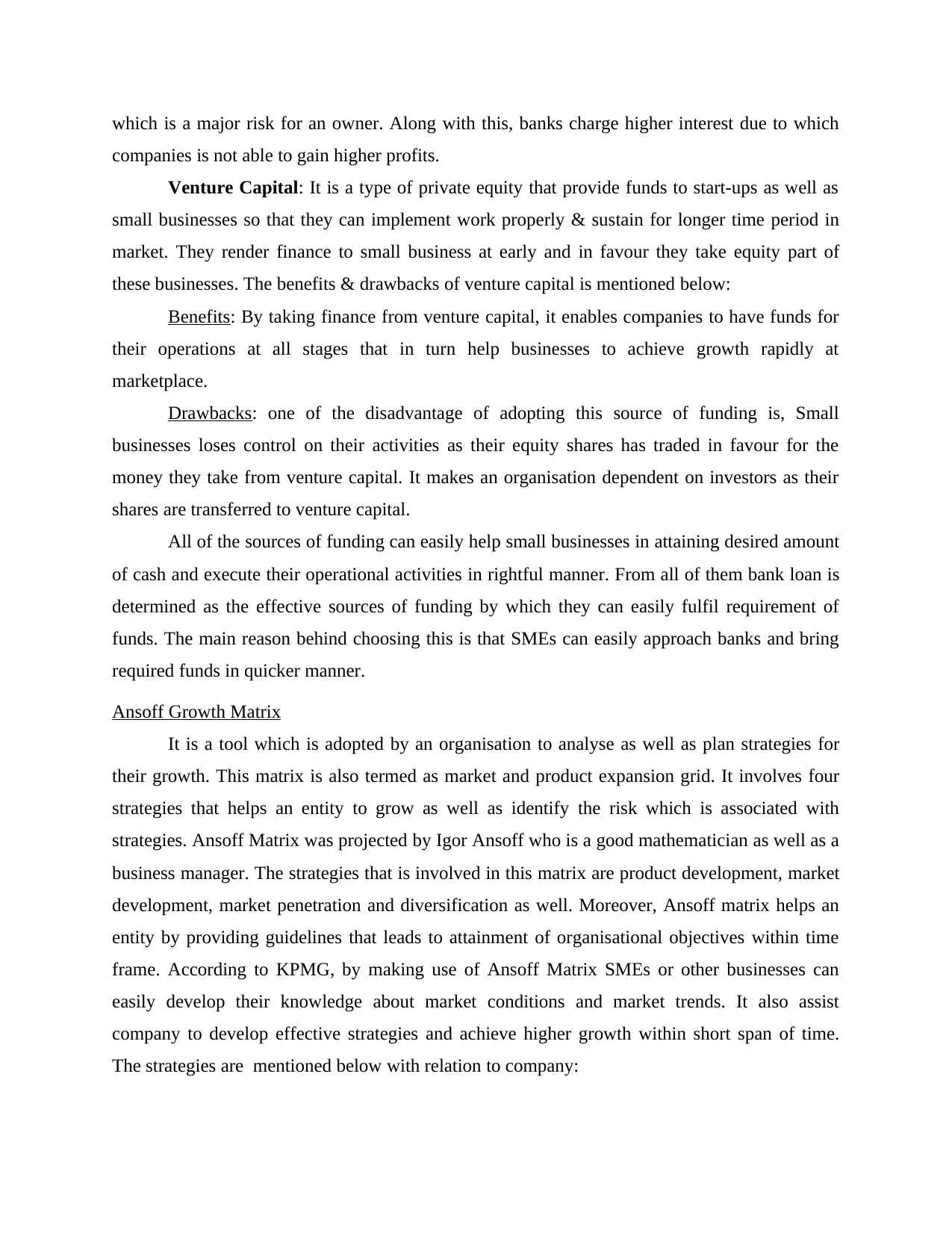
which is a major risk for an owner. Along with this, banks charge higher interest due to which
companies is not able to gain higher profits.
Venture Capital: It is a type of private equity that provide funds to start-ups as well as
small businesses so that they can implement work properly & sustain for longer time period in
market. They render finance to small business at early and in favour they take equity part of
these businesses. The benefits & drawbacks of venture capital is mentioned below:
Benefits: By taking finance from venture capital, it enables companies to have funds for
their operations at all stages that in turn help businesses to achieve growth rapidly at
marketplace.
Drawbacks: one of the disadvantage of adopting this source of funding is, Small
businesses loses control on their activities as their equity shares has traded in favour for the
money they take from venture capital. It makes an organisation dependent on investors as their
shares are transferred to venture capital.
All of the sources of funding can easily help small businesses in attaining desired amount
of cash and execute their operational activities in rightful manner. From all of them bank loan is
determined as the effective sources of funding by which they can easily fulfil requirement of
funds. The main reason behind choosing this is that SMEs can easily approach banks and bring
required funds in quicker manner.
Ansoff Growth Matrix
It is a tool which is adopted by an organisation to analyse as well as plan strategies for
their growth. This matrix is also termed as market and product expansion grid. It involves four
strategies that helps an entity to grow as well as identify the risk which is associated with
strategies. Ansoff Matrix was projected by Igor Ansoff who is a good mathematician as well as a
business manager. The strategies that is involved in this matrix are product development, market
development, market penetration and diversification as well. Moreover, Ansoff matrix helps an
entity by providing guidelines that leads to attainment of organisational objectives within time
frame. According to KPMG, by making use of Ansoff Matrix SMEs or other businesses can
easily develop their knowledge about market conditions and market trends. It also assist
company to develop effective strategies and achieve higher growth within short span of time.
The strategies are mentioned below with relation to company:
companies is not able to gain higher profits.
Venture Capital: It is a type of private equity that provide funds to start-ups as well as
small businesses so that they can implement work properly & sustain for longer time period in
market. They render finance to small business at early and in favour they take equity part of
these businesses. The benefits & drawbacks of venture capital is mentioned below:
Benefits: By taking finance from venture capital, it enables companies to have funds for
their operations at all stages that in turn help businesses to achieve growth rapidly at
marketplace.
Drawbacks: one of the disadvantage of adopting this source of funding is, Small
businesses loses control on their activities as their equity shares has traded in favour for the
money they take from venture capital. It makes an organisation dependent on investors as their
shares are transferred to venture capital.
All of the sources of funding can easily help small businesses in attaining desired amount
of cash and execute their operational activities in rightful manner. From all of them bank loan is
determined as the effective sources of funding by which they can easily fulfil requirement of
funds. The main reason behind choosing this is that SMEs can easily approach banks and bring
required funds in quicker manner.
Ansoff Growth Matrix
It is a tool which is adopted by an organisation to analyse as well as plan strategies for
their growth. This matrix is also termed as market and product expansion grid. It involves four
strategies that helps an entity to grow as well as identify the risk which is associated with
strategies. Ansoff Matrix was projected by Igor Ansoff who is a good mathematician as well as a
business manager. The strategies that is involved in this matrix are product development, market
development, market penetration and diversification as well. Moreover, Ansoff matrix helps an
entity by providing guidelines that leads to attainment of organisational objectives within time
frame. According to KPMG, by making use of Ansoff Matrix SMEs or other businesses can
easily develop their knowledge about market conditions and market trends. It also assist
company to develop effective strategies and achieve higher growth within short span of time.
The strategies are mentioned below with relation to company:
Paraphrase This Document
Need a fresh take? Get an instant paraphrase of this document with our AI Paraphraser
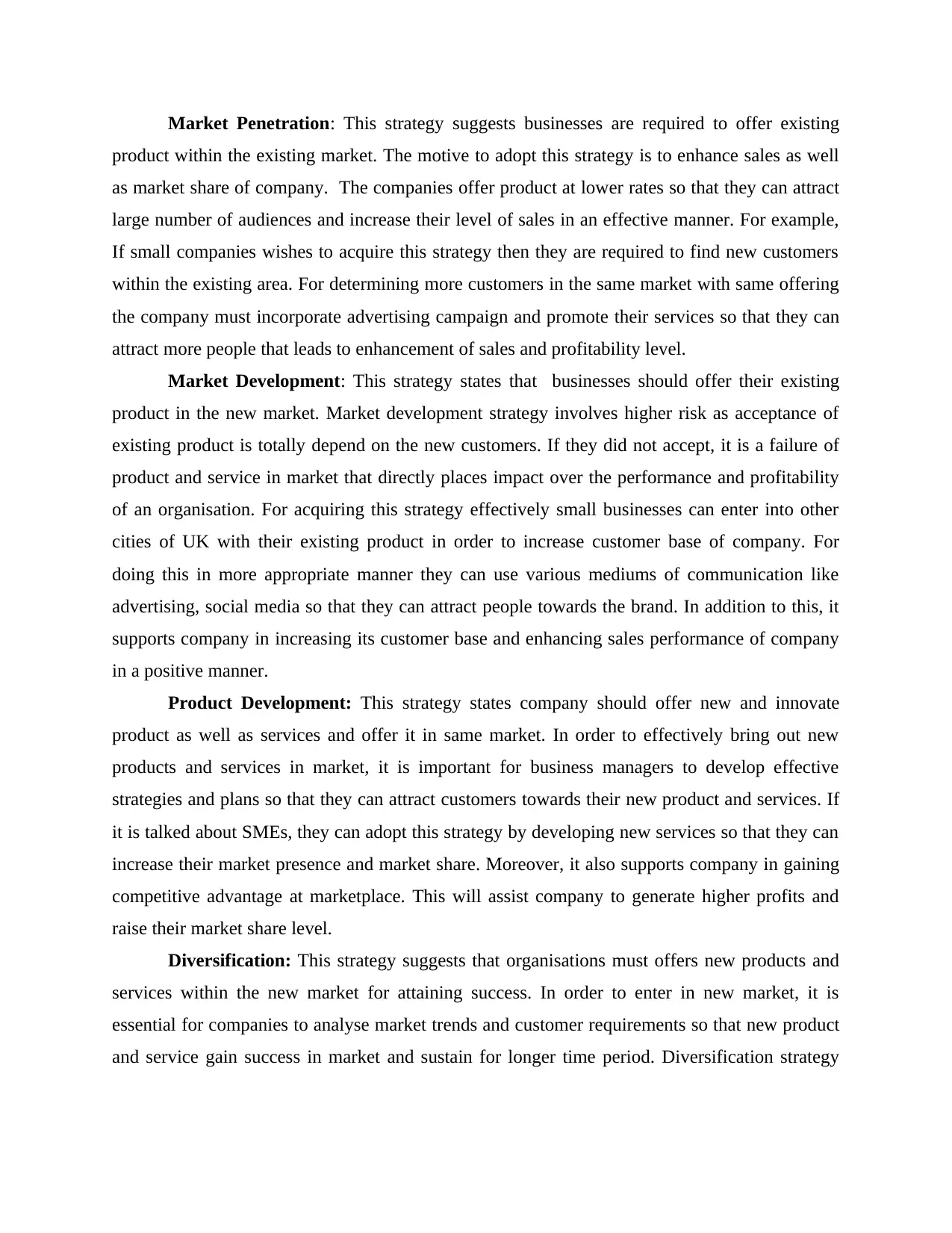
Market Penetration: This strategy suggests businesses are required to offer existing
product within the existing market. The motive to adopt this strategy is to enhance sales as well
as market share of company. The companies offer product at lower rates so that they can attract
large number of audiences and increase their level of sales in an effective manner. For example,
If small companies wishes to acquire this strategy then they are required to find new customers
within the existing area. For determining more customers in the same market with same offering
the company must incorporate advertising campaign and promote their services so that they can
attract more people that leads to enhancement of sales and profitability level.
Market Development: This strategy states that businesses should offer their existing
product in the new market. Market development strategy involves higher risk as acceptance of
existing product is totally depend on the new customers. If they did not accept, it is a failure of
product and service in market that directly places impact over the performance and profitability
of an organisation. For acquiring this strategy effectively small businesses can enter into other
cities of UK with their existing product in order to increase customer base of company. For
doing this in more appropriate manner they can use various mediums of communication like
advertising, social media so that they can attract people towards the brand. In addition to this, it
supports company in increasing its customer base and enhancing sales performance of company
in a positive manner.
Product Development: This strategy states company should offer new and innovate
product as well as services and offer it in same market. In order to effectively bring out new
products and services in market, it is important for business managers to develop effective
strategies and plans so that they can attract customers towards their new product and services. If
it is talked about SMEs, they can adopt this strategy by developing new services so that they can
increase their market presence and market share. Moreover, it also supports company in gaining
competitive advantage at marketplace. This will assist company to generate higher profits and
raise their market share level.
Diversification: This strategy suggests that organisations must offers new products and
services within the new market for attaining success. In order to enter in new market, it is
essential for companies to analyse market trends and customer requirements so that new product
and service gain success in market and sustain for longer time period. Diversification strategy
product within the existing market. The motive to adopt this strategy is to enhance sales as well
as market share of company. The companies offer product at lower rates so that they can attract
large number of audiences and increase their level of sales in an effective manner. For example,
If small companies wishes to acquire this strategy then they are required to find new customers
within the existing area. For determining more customers in the same market with same offering
the company must incorporate advertising campaign and promote their services so that they can
attract more people that leads to enhancement of sales and profitability level.
Market Development: This strategy states that businesses should offer their existing
product in the new market. Market development strategy involves higher risk as acceptance of
existing product is totally depend on the new customers. If they did not accept, it is a failure of
product and service in market that directly places impact over the performance and profitability
of an organisation. For acquiring this strategy effectively small businesses can enter into other
cities of UK with their existing product in order to increase customer base of company. For
doing this in more appropriate manner they can use various mediums of communication like
advertising, social media so that they can attract people towards the brand. In addition to this, it
supports company in increasing its customer base and enhancing sales performance of company
in a positive manner.
Product Development: This strategy states company should offer new and innovate
product as well as services and offer it in same market. In order to effectively bring out new
products and services in market, it is important for business managers to develop effective
strategies and plans so that they can attract customers towards their new product and services. If
it is talked about SMEs, they can adopt this strategy by developing new services so that they can
increase their market presence and market share. Moreover, it also supports company in gaining
competitive advantage at marketplace. This will assist company to generate higher profits and
raise their market share level.
Diversification: This strategy suggests that organisations must offers new products and
services within the new market for attaining success. In order to enter in new market, it is
essential for companies to analyse market trends and customer requirements so that new product
and service gain success in market and sustain for longer time period. Diversification strategy
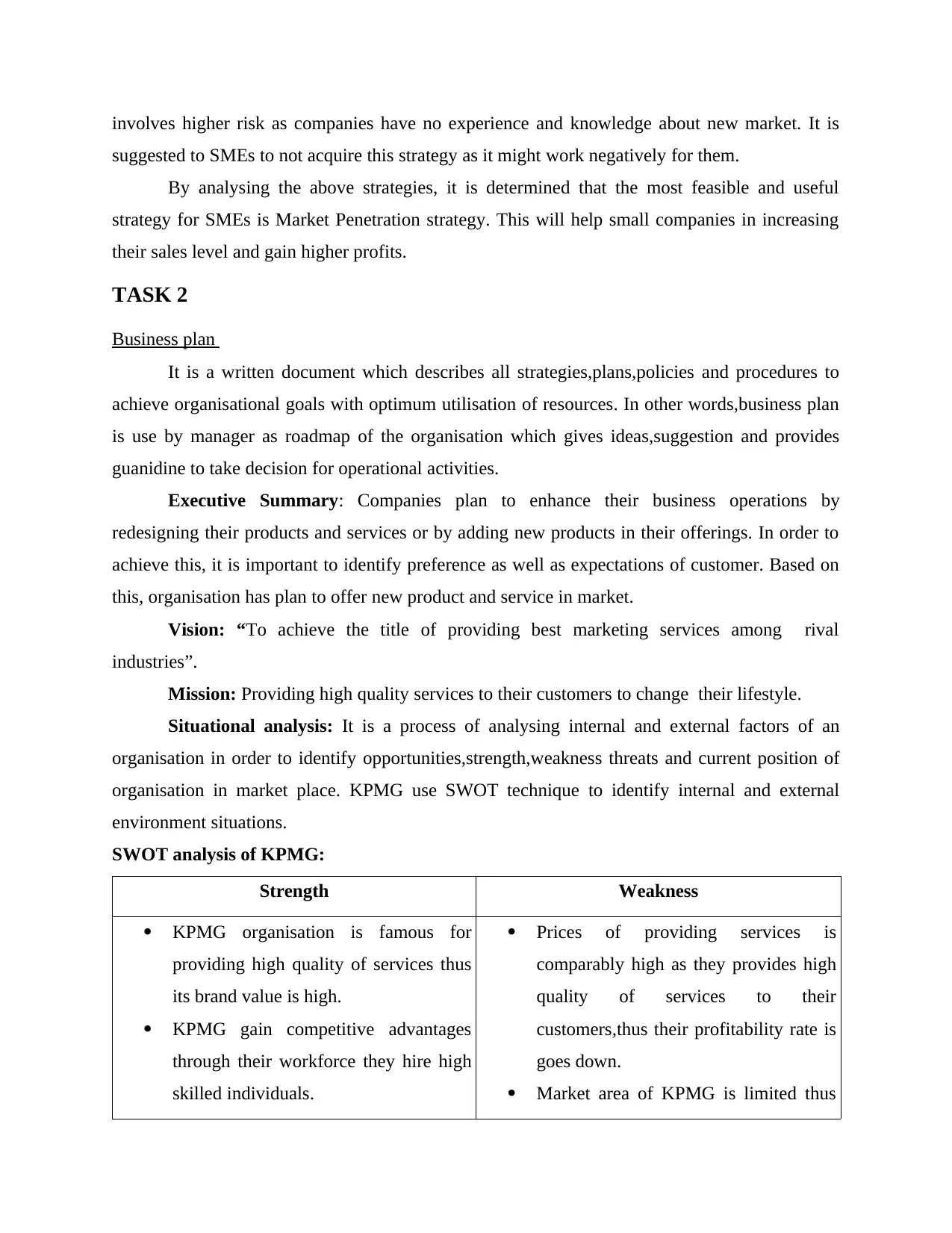
involves higher risk as companies have no experience and knowledge about new market. It is
suggested to SMEs to not acquire this strategy as it might work negatively for them.
By analysing the above strategies, it is determined that the most feasible and useful
strategy for SMEs is Market Penetration strategy. This will help small companies in increasing
their sales level and gain higher profits.
TASK 2
Business plan
It is a written document which describes all strategies,plans,policies and procedures to
achieve organisational goals with optimum utilisation of resources. In other words,business plan
is use by manager as roadmap of the organisation which gives ideas,suggestion and provides
guanidine to take decision for operational activities.
Executive Summary: Companies plan to enhance their business operations by
redesigning their products and services or by adding new products in their offerings. In order to
achieve this, it is important to identify preference as well as expectations of customer. Based on
this, organisation has plan to offer new product and service in market.
Vision: “To achieve the title of providing best marketing services among rival
industries”.
Mission: Providing high quality services to their customers to change their lifestyle.
Situational analysis: It is a process of analysing internal and external factors of an
organisation in order to identify opportunities,strength,weakness threats and current position of
organisation in market place. KPMG use SWOT technique to identify internal and external
environment situations.
SWOT analysis of KPMG:
Strength Weakness
KPMG organisation is famous for
providing high quality of services thus
its brand value is high.
KPMG gain competitive advantages
through their workforce they hire high
skilled individuals.
Prices of providing services is
comparably high as they provides high
quality of services to their
customers,thus their profitability rate is
goes down.
Market area of KPMG is limited thus
suggested to SMEs to not acquire this strategy as it might work negatively for them.
By analysing the above strategies, it is determined that the most feasible and useful
strategy for SMEs is Market Penetration strategy. This will help small companies in increasing
their sales level and gain higher profits.
TASK 2
Business plan
It is a written document which describes all strategies,plans,policies and procedures to
achieve organisational goals with optimum utilisation of resources. In other words,business plan
is use by manager as roadmap of the organisation which gives ideas,suggestion and provides
guanidine to take decision for operational activities.
Executive Summary: Companies plan to enhance their business operations by
redesigning their products and services or by adding new products in their offerings. In order to
achieve this, it is important to identify preference as well as expectations of customer. Based on
this, organisation has plan to offer new product and service in market.
Vision: “To achieve the title of providing best marketing services among rival
industries”.
Mission: Providing high quality services to their customers to change their lifestyle.
Situational analysis: It is a process of analysing internal and external factors of an
organisation in order to identify opportunities,strength,weakness threats and current position of
organisation in market place. KPMG use SWOT technique to identify internal and external
environment situations.
SWOT analysis of KPMG:
Strength Weakness
KPMG organisation is famous for
providing high quality of services thus
its brand value is high.
KPMG gain competitive advantages
through their workforce they hire high
skilled individuals.
Prices of providing services is
comparably high as they provides high
quality of services to their
customers,thus their profitability rate is
goes down.
Market area of KPMG is limited thus
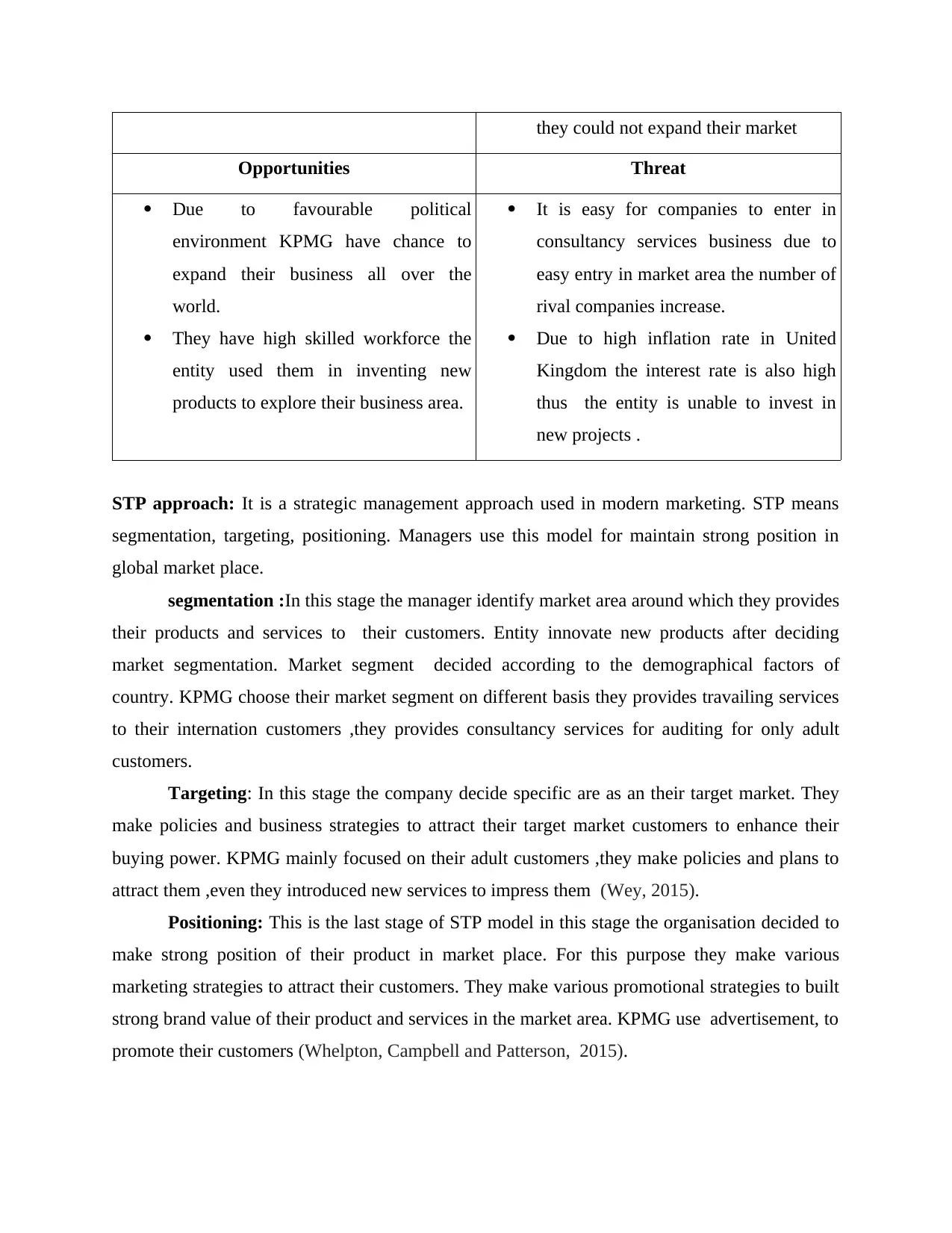
they could not expand their market
Opportunities Threat
Due to favourable political
environment KPMG have chance to
expand their business all over the
world.
They have high skilled workforce the
entity used them in inventing new
products to explore their business area.
It is easy for companies to enter in
consultancy services business due to
easy entry in market area the number of
rival companies increase.
Due to high inflation rate in United
Kingdom the interest rate is also high
thus the entity is unable to invest in
new projects .
STP approach: It is a strategic management approach used in modern marketing. STP means
segmentation, targeting, positioning. Managers use this model for maintain strong position in
global market place.
segmentation :In this stage the manager identify market area around which they provides
their products and services to their customers. Entity innovate new products after deciding
market segmentation. Market segment decided according to the demographical factors of
country. KPMG choose their market segment on different basis they provides travailing services
to their internation customers ,they provides consultancy services for auditing for only adult
customers.
Targeting: In this stage the company decide specific are as an their target market. They
make policies and business strategies to attract their target market customers to enhance their
buying power. KPMG mainly focused on their adult customers ,they make policies and plans to
attract them ,even they introduced new services to impress them (Wey, 2015).
Positioning: This is the last stage of STP model in this stage the organisation decided to
make strong position of their product in market place. For this purpose they make various
marketing strategies to attract their customers. They make various promotional strategies to built
strong brand value of their product and services in the market area. KPMG use advertisement, to
promote their customers (Whelpton, Campbell and Patterson, 2015).
Opportunities Threat
Due to favourable political
environment KPMG have chance to
expand their business all over the
world.
They have high skilled workforce the
entity used them in inventing new
products to explore their business area.
It is easy for companies to enter in
consultancy services business due to
easy entry in market area the number of
rival companies increase.
Due to high inflation rate in United
Kingdom the interest rate is also high
thus the entity is unable to invest in
new projects .
STP approach: It is a strategic management approach used in modern marketing. STP means
segmentation, targeting, positioning. Managers use this model for maintain strong position in
global market place.
segmentation :In this stage the manager identify market area around which they provides
their products and services to their customers. Entity innovate new products after deciding
market segmentation. Market segment decided according to the demographical factors of
country. KPMG choose their market segment on different basis they provides travailing services
to their internation customers ,they provides consultancy services for auditing for only adult
customers.
Targeting: In this stage the company decide specific are as an their target market. They
make policies and business strategies to attract their target market customers to enhance their
buying power. KPMG mainly focused on their adult customers ,they make policies and plans to
attract them ,even they introduced new services to impress them (Wey, 2015).
Positioning: This is the last stage of STP model in this stage the organisation decided to
make strong position of their product in market place. For this purpose they make various
marketing strategies to attract their customers. They make various promotional strategies to built
strong brand value of their product and services in the market area. KPMG use advertisement, to
promote their customers (Whelpton, Campbell and Patterson, 2015).
Secure Best Marks with AI Grader
Need help grading? Try our AI Grader for instant feedback on your assignments.

TASK 3
Assessing exit and succession options for small businesses with their advantages & drawbacks.
Merger and Acquisition: Small business entities uses merger and acquisition policy for
the purpose of winding up their business. Merger is a condition where two entity wind up their
business and make a new entity, and acquisition is a strategy where one business entity buys
another business entity in order to expand their business and increase their financial capabilities.
Benefits of merger and acquisition policy: Following are the benefits of adopting
these strategies:
Due to lack of financial capital small business cannot survive in market,merger and
antiquation help to increase financial capital because in this strategy two firms are
combined.
Governments provides various schemes and benefits to those organisation which use
these strategies,they get relief in their tax policies.
It helps in creating economic scale, after merging company produce their products on
large scales it reduce their cost price of per unit and help in gain efficiency in their
performance level.
Drawbacks of merger and acquisition:
One of the biggest drawbacks of this strategy is that company becomes bigger and take
monopoly in the market place.
Lack of communication is biggest disadvantage as there will be conflict arise after
merging of two entities.
Liquidation: It is a process of winding up of an organisation by selling all their assets.
Organisation use this strategy when they suffering from high rescission period in their life cycle .
Benefits of choosing liquidation strategy are as follows:
Organisations debt are realise after liquidation process the managers enjoy no liability
after this process.
The most useful benefit of choosing this strategy is that governments legal actions are
closed. There will be no boundation and extra charges pay by company.
If organisation take lease then their lease period is end and entity is no longer libel to pay
lease amount.
Assessing exit and succession options for small businesses with their advantages & drawbacks.
Merger and Acquisition: Small business entities uses merger and acquisition policy for
the purpose of winding up their business. Merger is a condition where two entity wind up their
business and make a new entity, and acquisition is a strategy where one business entity buys
another business entity in order to expand their business and increase their financial capabilities.
Benefits of merger and acquisition policy: Following are the benefits of adopting
these strategies:
Due to lack of financial capital small business cannot survive in market,merger and
antiquation help to increase financial capital because in this strategy two firms are
combined.
Governments provides various schemes and benefits to those organisation which use
these strategies,they get relief in their tax policies.
It helps in creating economic scale, after merging company produce their products on
large scales it reduce their cost price of per unit and help in gain efficiency in their
performance level.
Drawbacks of merger and acquisition:
One of the biggest drawbacks of this strategy is that company becomes bigger and take
monopoly in the market place.
Lack of communication is biggest disadvantage as there will be conflict arise after
merging of two entities.
Liquidation: It is a process of winding up of an organisation by selling all their assets.
Organisation use this strategy when they suffering from high rescission period in their life cycle .
Benefits of choosing liquidation strategy are as follows:
Organisations debt are realise after liquidation process the managers enjoy no liability
after this process.
The most useful benefit of choosing this strategy is that governments legal actions are
closed. There will be no boundation and extra charges pay by company.
If organisation take lease then their lease period is end and entity is no longer libel to pay
lease amount.
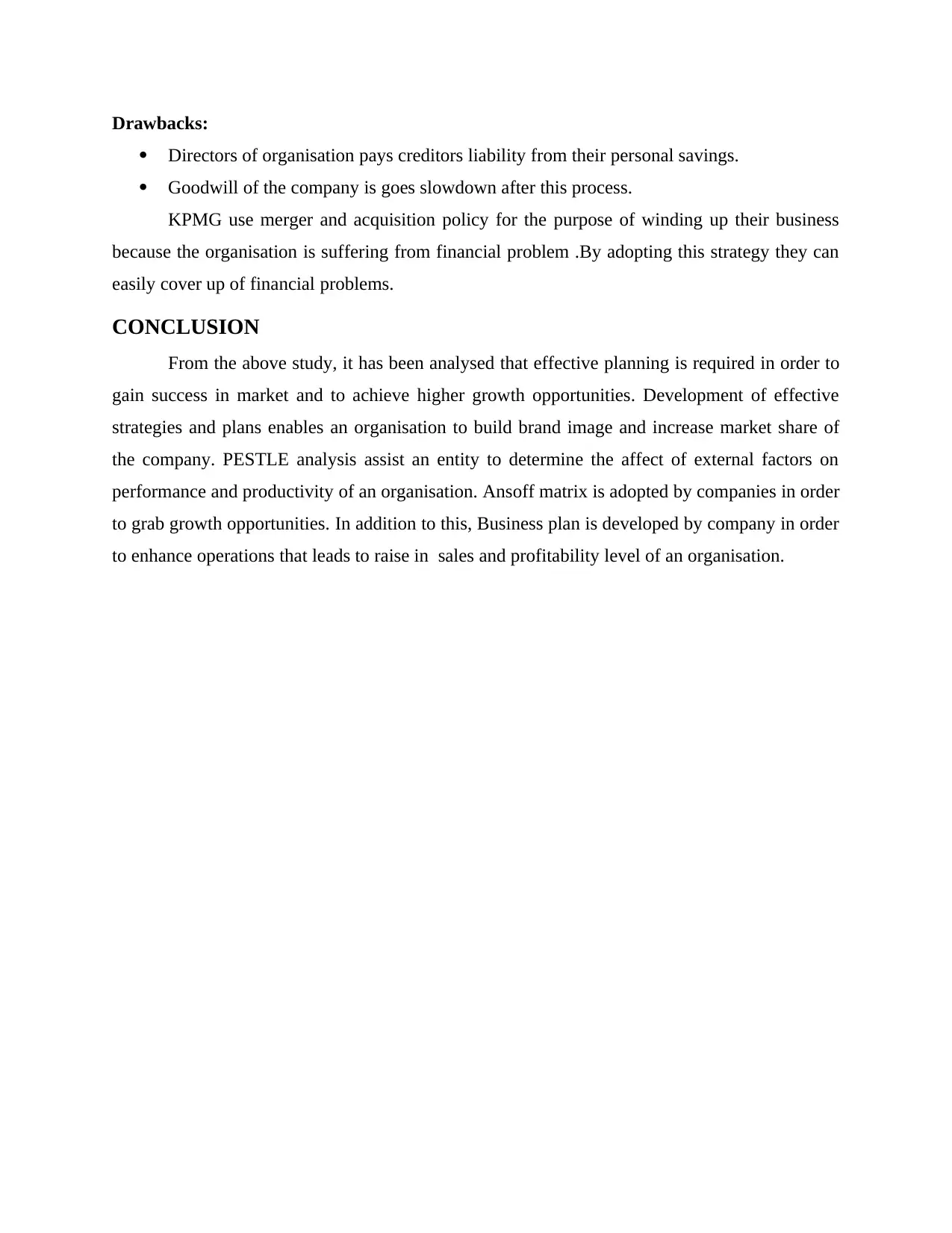
Drawbacks:
Directors of organisation pays creditors liability from their personal savings.
Goodwill of the company is goes slowdown after this process.
KPMG use merger and acquisition policy for the purpose of winding up their business
because the organisation is suffering from financial problem .By adopting this strategy they can
easily cover up of financial problems.
CONCLUSION
From the above study, it has been analysed that effective planning is required in order to
gain success in market and to achieve higher growth opportunities. Development of effective
strategies and plans enables an organisation to build brand image and increase market share of
the company. PESTLE analysis assist an entity to determine the affect of external factors on
performance and productivity of an organisation. Ansoff matrix is adopted by companies in order
to grab growth opportunities. In addition to this, Business plan is developed by company in order
to enhance operations that leads to raise in sales and profitability level of an organisation.
Directors of organisation pays creditors liability from their personal savings.
Goodwill of the company is goes slowdown after this process.
KPMG use merger and acquisition policy for the purpose of winding up their business
because the organisation is suffering from financial problem .By adopting this strategy they can
easily cover up of financial problems.
CONCLUSION
From the above study, it has been analysed that effective planning is required in order to
gain success in market and to achieve higher growth opportunities. Development of effective
strategies and plans enables an organisation to build brand image and increase market share of
the company. PESTLE analysis assist an entity to determine the affect of external factors on
performance and productivity of an organisation. Ansoff matrix is adopted by companies in order
to grab growth opportunities. In addition to this, Business plan is developed by company in order
to enhance operations that leads to raise in sales and profitability level of an organisation.
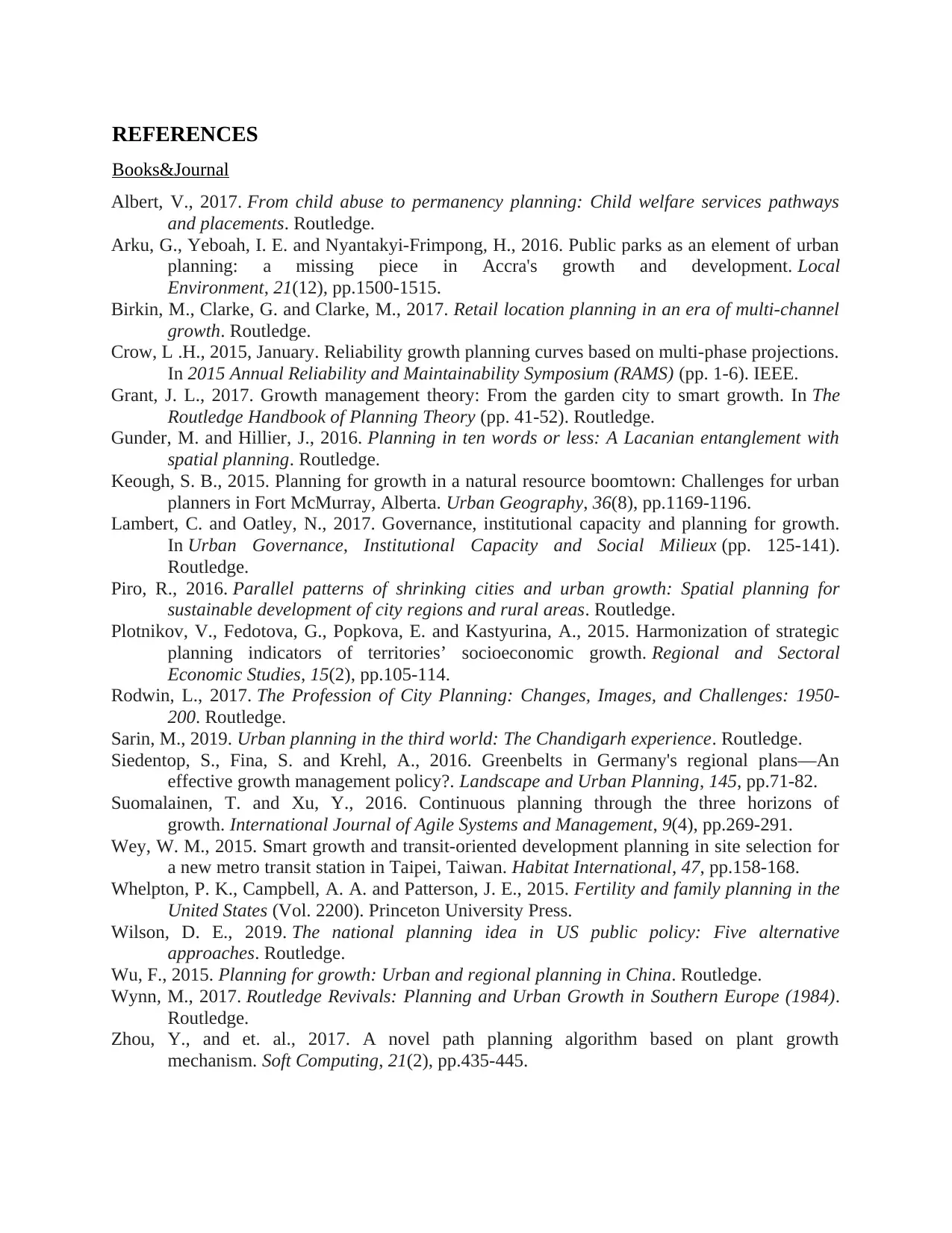
REFERENCES
Books&Journal
Albert, V., 2017. From child abuse to permanency planning: Child welfare services pathways
and placements. Routledge.
Arku, G., Yeboah, I. E. and Nyantakyi-Frimpong, H., 2016. Public parks as an element of urban
planning: a missing piece in Accra's growth and development. Local
Environment, 21(12), pp.1500-1515.
Birkin, M., Clarke, G. and Clarke, M., 2017. Retail location planning in an era of multi-channel
growth. Routledge.
Crow, L .H., 2015, January. Reliability growth planning curves based on multi-phase projections.
In 2015 Annual Reliability and Maintainability Symposium (RAMS) (pp. 1-6). IEEE.
Grant, J. L., 2017. Growth management theory: From the garden city to smart growth. In The
Routledge Handbook of Planning Theory (pp. 41-52). Routledge.
Gunder, M. and Hillier, J., 2016. Planning in ten words or less: A Lacanian entanglement with
spatial planning. Routledge.
Keough, S. B., 2015. Planning for growth in a natural resource boomtown: Challenges for urban
planners in Fort McMurray, Alberta. Urban Geography, 36(8), pp.1169-1196.
Lambert, C. and Oatley, N., 2017. Governance, institutional capacity and planning for growth.
In Urban Governance, Institutional Capacity and Social Milieux (pp. 125-141).
Routledge.
Piro, R., 2016. Parallel patterns of shrinking cities and urban growth: Spatial planning for
sustainable development of city regions and rural areas. Routledge.
Plotnikov, V., Fedotova, G., Popkova, E. and Kastyurina, A., 2015. Harmonization of strategic
planning indicators of territories’ socioeconomic growth. Regional and Sectoral
Economic Studies, 15(2), pp.105-114.
Rodwin, L., 2017. The Profession of City Planning: Changes, Images, and Challenges: 1950-
200. Routledge.
Sarin, M., 2019. Urban planning in the third world: The Chandigarh experience. Routledge.
Siedentop, S., Fina, S. and Krehl, A., 2016. Greenbelts in Germany's regional plans—An
effective growth management policy?. Landscape and Urban Planning, 145, pp.71-82.
Suomalainen, T. and Xu, Y., 2016. Continuous planning through the three horizons of
growth. International Journal of Agile Systems and Management, 9(4), pp.269-291.
Wey, W. M., 2015. Smart growth and transit-oriented development planning in site selection for
a new metro transit station in Taipei, Taiwan. Habitat International, 47, pp.158-168.
Whelpton, P. K., Campbell, A. A. and Patterson, J. E., 2015. Fertility and family planning in the
United States (Vol. 2200). Princeton University Press.
Wilson, D. E., 2019. The national planning idea in US public policy: Five alternative
approaches. Routledge.
Wu, F., 2015. Planning for growth: Urban and regional planning in China. Routledge.
Wynn, M., 2017. Routledge Revivals: Planning and Urban Growth in Southern Europe (1984).
Routledge.
Zhou, Y., and et. al., 2017. A novel path planning algorithm based on plant growth
mechanism. Soft Computing, 21(2), pp.435-445.
Books&Journal
Albert, V., 2017. From child abuse to permanency planning: Child welfare services pathways
and placements. Routledge.
Arku, G., Yeboah, I. E. and Nyantakyi-Frimpong, H., 2016. Public parks as an element of urban
planning: a missing piece in Accra's growth and development. Local
Environment, 21(12), pp.1500-1515.
Birkin, M., Clarke, G. and Clarke, M., 2017. Retail location planning in an era of multi-channel
growth. Routledge.
Crow, L .H., 2015, January. Reliability growth planning curves based on multi-phase projections.
In 2015 Annual Reliability and Maintainability Symposium (RAMS) (pp. 1-6). IEEE.
Grant, J. L., 2017. Growth management theory: From the garden city to smart growth. In The
Routledge Handbook of Planning Theory (pp. 41-52). Routledge.
Gunder, M. and Hillier, J., 2016. Planning in ten words or less: A Lacanian entanglement with
spatial planning. Routledge.
Keough, S. B., 2015. Planning for growth in a natural resource boomtown: Challenges for urban
planners in Fort McMurray, Alberta. Urban Geography, 36(8), pp.1169-1196.
Lambert, C. and Oatley, N., 2017. Governance, institutional capacity and planning for growth.
In Urban Governance, Institutional Capacity and Social Milieux (pp. 125-141).
Routledge.
Piro, R., 2016. Parallel patterns of shrinking cities and urban growth: Spatial planning for
sustainable development of city regions and rural areas. Routledge.
Plotnikov, V., Fedotova, G., Popkova, E. and Kastyurina, A., 2015. Harmonization of strategic
planning indicators of territories’ socioeconomic growth. Regional and Sectoral
Economic Studies, 15(2), pp.105-114.
Rodwin, L., 2017. The Profession of City Planning: Changes, Images, and Challenges: 1950-
200. Routledge.
Sarin, M., 2019. Urban planning in the third world: The Chandigarh experience. Routledge.
Siedentop, S., Fina, S. and Krehl, A., 2016. Greenbelts in Germany's regional plans—An
effective growth management policy?. Landscape and Urban Planning, 145, pp.71-82.
Suomalainen, T. and Xu, Y., 2016. Continuous planning through the three horizons of
growth. International Journal of Agile Systems and Management, 9(4), pp.269-291.
Wey, W. M., 2015. Smart growth and transit-oriented development planning in site selection for
a new metro transit station in Taipei, Taiwan. Habitat International, 47, pp.158-168.
Whelpton, P. K., Campbell, A. A. and Patterson, J. E., 2015. Fertility and family planning in the
United States (Vol. 2200). Princeton University Press.
Wilson, D. E., 2019. The national planning idea in US public policy: Five alternative
approaches. Routledge.
Wu, F., 2015. Planning for growth: Urban and regional planning in China. Routledge.
Wynn, M., 2017. Routledge Revivals: Planning and Urban Growth in Southern Europe (1984).
Routledge.
Zhou, Y., and et. al., 2017. A novel path planning algorithm based on plant growth
mechanism. Soft Computing, 21(2), pp.435-445.
Paraphrase This Document
Need a fresh take? Get an instant paraphrase of this document with our AI Paraphraser

1 out of 14
Related Documents
Your All-in-One AI-Powered Toolkit for Academic Success.
+13062052269
info@desklib.com
Available 24*7 on WhatsApp / Email
![[object Object]](/_next/static/media/star-bottom.7253800d.svg)
Unlock your academic potential
© 2024 | Zucol Services PVT LTD | All rights reserved.





